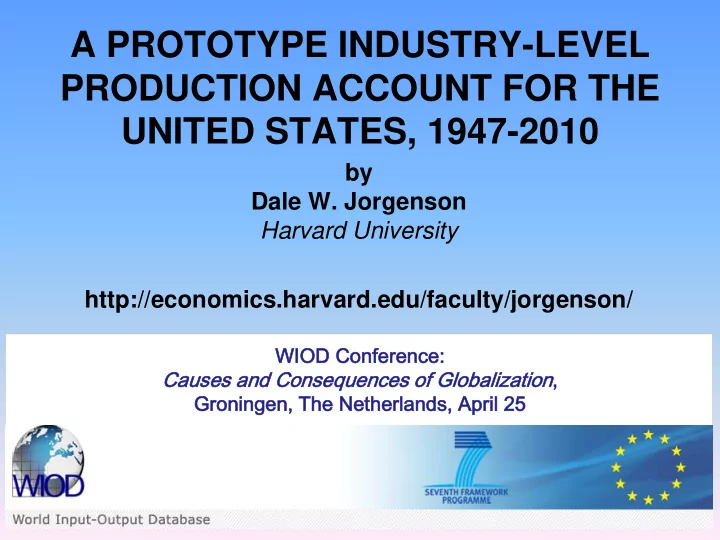

A PROTOTYPE INDUSTRY-LEVEL PRODUCTION ACCOUNT FOR THE UNITED STATES, 1947-2010 by Dale W. Jorgenson Harvard University http://economics.harvard.edu/faculty/jorgenson/ WI WIOD Co Conf nference nce: Ca Caus uses an and Co Conseq equen ences o of Global alizat ation , Groni ning ngen, The The Net Nether erland nds, A April 25
ACKNOWLEDGEMENTS The data presented in this lecture were prepared by Dale W. Jorgenson, Mun S. Ho, and Jon D. Samuels. We are indebted to Mark Planting, Erich Strassner, and the Industry Division of the Bureau of Economic Analysis for time series data on input-output tables in current prices and to Ankur Patel for his help with the data construction. We are grateful to Trina Ott for preparing the presentation. Financial support was provided by the Donald Marron Gift Fund at Harvard University. The usual disclaimer applies.
A PROTOTYPE INDUSTRY-LEVEL PRODUCTION ACCOUNT FOR THE UNITED STATES, 1947-2010 Table of Contents Annual Make and Use Tables in Current and Constant Prices, 1947-2010 65 Industry Sectors; NAICS Industrial Classifcation. Annual Capital, Labor, Energy, Materials, and Services Data in Current and Constant Prices, 1947-2010 Capital Data Divided between IT and Non-IT; Labor Data Divided between Hours and Labor Quality. Postwar U.S. Economic History The Postwar Recovery, the Big Slump, and the Great Recession Projecting Technology and Economic Growth Substitution versus Technical Change
THE HISTORICAL BACKGROUND Benchmark Input-Output Tables for the United States 1947, 1958, 1963, Five-Year Intervals Since 1967 Annual Input-Output Tables for the United States 1998-2010 on a Continuously Revised Basis Time Series of Input-Output Tables for the United States Jorgenson, Gollop and Fraumeni (1987), 1948-1979 Jorgenson, Ho and Stiroh (2005), 1977-2000 Jorgenson, Ho and Samuels (2012), 1960-2007
IT-RELATED INDUSTRIES IT-Producing Industries Computer and electronic products Information and data processing services Computer systems design and related services IT-Using Industries Machinery Securities commodity contracts and investments Other transportation equipment Insurance carriers and related activities Furniture and related products Rental and leasing services and lessors of intangible Miscellaneous manufacturing assets Printing and related support activities Legal services Wholesale Trade Misc. professional scientific and technical services Retail Trade Management of companies and enterprises Air transportation Administrative and support services Water transportation Educational services Truck transportation Ambulatory health care services Pipeline transportation Hospitals Nursing and residential care facilities Publishing industries (includes software) Social assistance Motion picture and sound recording Performing arts spectator sports museums and related industries activities Broadcasting and telecommunications Other services except government Federal Reserve banks credit Federal General government intermediation and related activities S&L Government enterprises
NON-IT INDUSTRIES Farms Paper products Forestry fishing and related activities Petroleum and coal products Oil and gas extraction Chemical products Mining except oil and gas Plastics and rubber products Rail transportation Support activities for mining Utilities Transit and ground passenger transportation Construction Other transportation and support activities Wood products Warehousing and storage Nonmetallic mineral products Funds trusts and other financial vehicles Real estate Primary metals Fabricated metal products Waste management and remediation services Electrical equipment appliances and Amusements gambling and recreation components industries Motor vehicles bodies and trailers and parts Accommodation Food and beverage and tobacco products Food services and drinking places Textile mills and textile product mills Federal Government enterprises Apparel and leather and allied products S&L General Government
ROLE OF INFORMATION TECHNOLOGY Growth of Value Added and Productivity Output Shares of IT Computers, Information and Data Processing Services, Computer Systems Design and Related Services Output Contributions by Type Computers, Information and Data Processing Services, Computer Systems Design and Related Services Output Contribution of IT IT-Producing, IT-Using, and Non-IT
Contributions of Individual Industries to Value Added Growth
ROLE OF TOTAL FACTOR PRODUCTIVITY Total Factor Productivity IT-Producing, IT-Using and Non-IT Industries Reallocation of Factor Inputs Capital Input and Labor Input Aggregate Productivity Growth Industry Productivity and Factor Reallocations
Contributions of Individual Industries to Productivity Growth
SOURCES OF U.S. ECONOMIC GROWTH, 1947-2010 Contribution of Capital Input IT and Non-IT Capital Contribution of Labor Input Hours and Labor Quallity Contribution of Productivity Replication vs. Innovation
PROJECTING TECHNOLOGY AND ECONOMIC GROWTH Substitution versus Technical Change Substitution among Inputs Capital, Labor, Energy, and Materials Biases of Technical Change Capital, Labor, Energy, and Materials Rate of Technical Change Autonomous and Induced Technical Change
A PROTOTYPE INDUSTRY-LEVEL PRODUCTION ACCOUNT FOR THE UNITED STATES, 1947-2010 Summary and Conclusions Sources of U.S. Economic Growth Replication versus Innovation Postwar U.S. Economic History The Postwar Recovery, the Big Slump and the Great Recession Projecting Technology and Economic Growth Substitution versus Technical Change
Recommend
More recommend